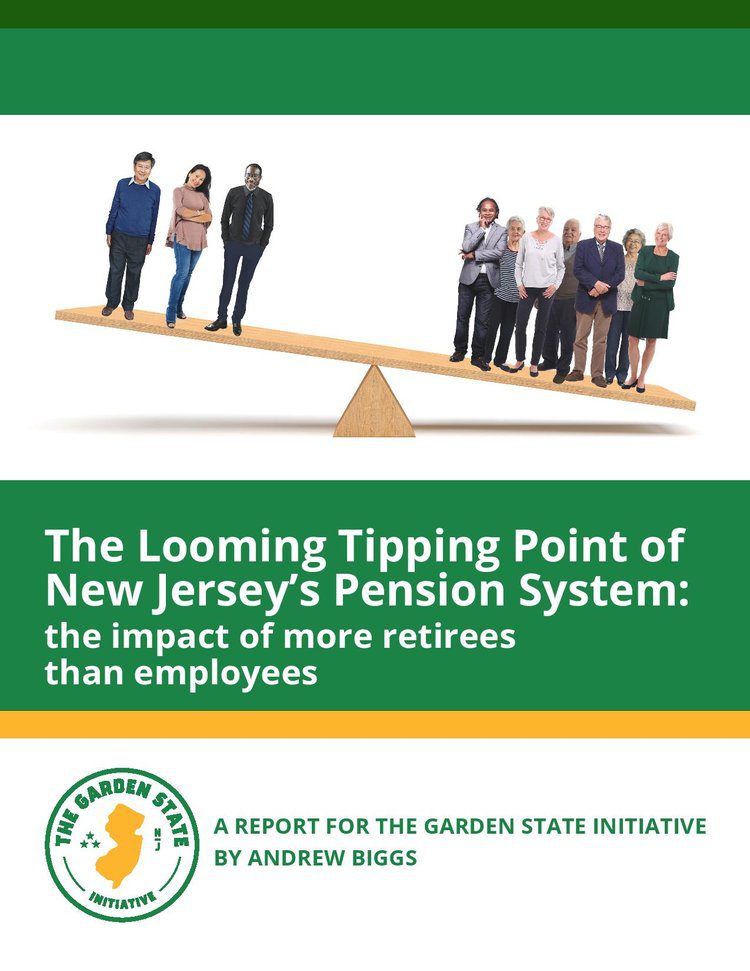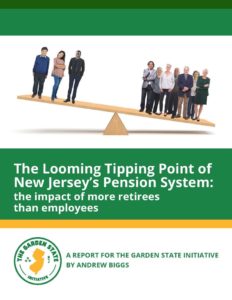Unemployment, GOVERNMENT THAT WORKS
GSI Report: NJ Pension Fund Crossing the Tipping Point: Looming impact of more retirees than employees

Comprehensive Analysis Showcases Public Impacts and Outlines Policy Solutions
-
Aging demographics of public workforce accelerating financial pressure
-
Current NJ pension system is on average 4Xs more generous than typical 401(k) plans
-
Need to increase shared risk between government and its employees on their retirement
 As New Jersey’s Legislature takes up a proposal to add themselves back into the struggling public pension system, the Garden State Initiative released today a new report which showcases why this idea only exacerbates New Jersey’s tenuous Pension system. The comprehensive analysis, entitled, The Looming Tipping Point of New Jersey’s Pension System: the impact of more retirees than employees, examines the powerful and long-standing pressure New Jersey’s pension system has had on the NJ state budget and our property taxes. The report was authored by Andrew G. Biggs, Ph.D., a Senior Fellow at the American Enterprise Institute (AEI), and outlines a series of non-partisan recommendations for policymakers.
As New Jersey’s Legislature takes up a proposal to add themselves back into the struggling public pension system, the Garden State Initiative released today a new report which showcases why this idea only exacerbates New Jersey’s tenuous Pension system. The comprehensive analysis, entitled, The Looming Tipping Point of New Jersey’s Pension System: the impact of more retirees than employees, examines the powerful and long-standing pressure New Jersey’s pension system has had on the NJ state budget and our property taxes. The report was authored by Andrew G. Biggs, Ph.D., a Senior Fellow at the American Enterprise Institute (AEI), and outlines a series of non-partisan recommendations for policymakers.
“For years, our pension system has hovered like a dark cloud looming over our economy, escalating pressure for taxpayers, for financial analysts, and our public employees themselves, yet we continue to kick the can and make little to no progress implementing solutions,” stated GSI’s president Regina M. Egea. “GSI invested in this substantial report to challenge our elected leaders to prioritize fixing this issue in the next legislative session, not make matters worse as has been proposed in the Senate. Deciding to acknowledge and address our pension crisis is not a conservative or liberal policy issue. We must all work together to strengthen our local economy and ensure economic equity in the entire State – and we cannot achieve this goal when we ignore our single most pressing issue.”
“We can first begin addressing New Jersey’s pension crisis by ensuring more people understand how it affects all of us,” stated Dr. Biggs. “Often, the discussion about the New Jersey pension debacle focuses on the mistakes New Jersey has made in the past, and not enough on how it is curtailing our everyday services with our schools, municipal services and law enforcement. This report provides both a clear historical perspective, why it matters to everyone who lives or works in New Jersey, as well as defines reasonable, common-sense solutions to improve all of our futures.”
Since 2001, New Jersey has seen its Public Employees Retirement System (PERS), the New Jersey Teachers pension plan (TPAF), and the New Jersey Police and Fire (PFRS) pension plans experience a more precipitous financial decline than any other pension plan in the county. Developing trends in our workforce, the return on investments made by the Pension Fund, as well as the relative competitiveness of what our pension system provides to employees, are all explored and addressed in this report. Among the key findings:
-
The reality of the demographics of plan participants has not been adequately reflected in current policy debates: the profile of participants in New Jersey’s main public plans have aged considerably since the turn of the 21st century but little has changed to reflect this reality. A pension system with older demographics is less able to handle investment risk, and fewer active workers supporting a growing number of retirees is accelerating pressure for more, not less, government funding.
-
New Jersey’s public plans cannot invest their way out of their unfunded liabilities: The three main New Jersey public employee retirement plans assumed 8.75 percent annual returns for coming years. However, in the 19 years since then, New Jersey’s pensions received annualized returns of just 5.40 percent. Roughly speaking, a 1 percentage point drop in the investment return/discount rate reduces the funded ratio for a public plan by about 20 percentage points. Given the sensitivity of pension funding health to investment returns, a nearly two-decade period of returns over three percentage points below the assumed rate will have disastrous effects on any defined benefit pension system.
-
New Jersey’s pension system costs more than most other states and is more generous than what New Jersey’s private-sector employees receive: New Jersey’s taxpayers have borne most pension cost increases. Specifically, the actuarially determined employer contribution rate for New Jersey PERS has increased from less than 1 percent of employee payroll in 2001 to over 25 percent of wages in 2019. Over that same period, the average employee contribution rose from 5.4 percent to 7.7 percent of wages, a significantly smaller increase than in contributions paid by the government/taxpayers.
When a new session of the Legislature is seated in January, resolving New Jersey’s pension crisis should be at the top of the agenda. This report defines the stakes for all Garden State residents and provides a non-ideological road map that can set our state on a course towards fiscal health and economic prosperity for all New Jerseyans.
The report was also the focus of the latest edition of The GSI Briefing podcast, which features a conversation with the Report’s author Andrew Biggs and Seton Hall Economics Professor Danielle Zanzalari, Ph.D. Click below to listen.

